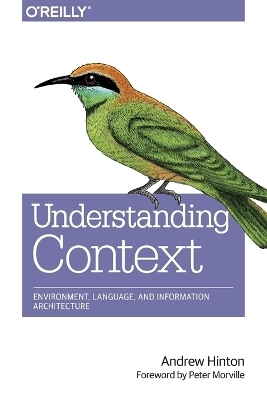
Understanding Context
O'Reilly Media (Verlag)
978-1-4493-2317-2 (ISBN)
This practical, insightful book provides a powerful toolset to help information architects, UX professionals, and web and app designers understand and solve the many challenges of contextual ambiguity in the products and services they create. You’ll discover not only how to design for a given context, but also how design participates in making context.
Topics included:
- Learn how people perceive context when touching and navigating digital environments
- See how labels, relationships, and rules work as building blocks for context
- Find out how to make better sense of cross-channel, multi-device products or services
- Discover how language creates infrastructure in organizations, software, and the Internet of Things
- Learn models for figuring out the contextual angles of any user experience
Andrew Hinton is a well-known speaker, writer and long-time community member of the information architecture, interaction design & user experience fields, as well as a co-founder and past board member of the IA Institute. But besides all that, he's a dad, a husband and the keeper of a "spirited" Boston Terrier named Sigmund.
The Context Problem
Chapter 1 Everything, Yet Something
Birds in Trees, Words in Books
Scenario: Andrew Goes to the Airport
Breaking It Down
Chapter 2 A Growing Challenge
Early Disruptions
The Role of the Web
Case Study: Facebook Beacon
Chapter 3 Environments, Elements, and Information
A Wall and a Field
A Conventional Definition of Context
A New, Working Definition of Context
Modes of Information
Starting from the Bottom
Physical Information
Chapter 4 Perception, Cognition, and Affordance
Information of a Different Sort
A Mainstream View of Cognition
Embodied Cognition: An Alternative View
Action and the Perceptual System
Information Pickup
Affordance
Directly Perceived versus Indirectly Meaningful
Soft Assembly
“Satisficing”
Umwelts
Chapter 5 Attention, Control, and Learning
A Spectrum of Conscious Attention
Environmental Control
Memory, and Learning the Environment
What Does All This Mean for Design?
Chapter 6 The Elements of the Environment
Invariants
The Principle of Nesting
Surface, Substance, Medium
Objects
Layout
Events
Place
Chapter 7 What Humans Make
The Built Environment
The Social Environment
Meaning, Culture, and “Product”
Semantic Information
Chapter 8 How Language Works
Looking at Language
Signs: Icons, Indexes, and Symbols
The Superpowers of Symbols
Signification Conflation
Language Is Contextual
Chapter 9 Language as Infrastructure
Language and the Body
Structure of Speech
The Role of Metaphor
Visual Information
Semantic Function
Tools for Understanding
Semantic Architecture
Chapter 10 The Written Word
The Origins of Writing
What Writing Does
The Structure of Writing
Rules and Systems
Chapter 11 Making Things Make Sense
Language and “Sensemaking”
Physical and Semantic Intersections
Physical and Semantic Confusion
Ducks, Rabbits, and Calendars
Digital Information
Chapter 12 Digital Cognition and Agency
Shannon’s Logic
Digital Learning and Agency
Everyday Digital Agents
Ontologies
Chapter 13 Digital Interaction
Interfaces and Humans
Semantic Function of Simulated Objects
Modes and Meaning
Chapter 14 Digital Environment
Variant Modes and Digital Places
Foraging for Information
Inhabiting Two Worlds at Once
Ambient Agents
The Maps We Live In
Chapter 15 Information as Architecture
Contemplating “Cyberspace”
Architecture + Information
Expansive IA
About Definitions
Chapter 16 Mapping and Placemaking
Maps and Territory
What Makes Places
Railroads, Chickens, and Captain Vancouver
Organizational Maps
Chapter 17 Virtual and Ambient Places
Of Dungeons and Quakes
The Porous Nature of Cyberplaces
Augmented and Blended Places
The Map That Makes Itself
Metamaps and Compasses
Chapter 18 The Social Map
Conversation
Social Architectures
“Proxemics” as a Structural Model
Identity
Collisions and Fronts
The Ontology of Self
Networked Publics
Composing Context
Chapter 19 Arrangement and Substance
Composition in Other Disciplines
Qualities of Composition
Something to Walk On
Chapter 20 The Materials of Semantic Function
Elements
Labels and Ontology
Relationships and Taxonomy
Rules and Choreography
The Organization as Medium
Chapter 21 Narratives and Situations
People Make Sense Through Stories
Intentions and Intersections
The Tales Organizations Tell
Situations over Goals
Chapter 22 Models and Making
A Fresh Look at Our Methods
Observing Context
Perspectives and Journeys
Structures for Tacit Satisficing
Blueprints, Floor Plans, Bubbles, and Blobs
Appendix Coda
Appendix About the Author
Appendix Understanding Context
| Erscheint lt. Verlag | 13.1.2015 |
|---|---|
| Verlagsort | Sebastopol |
| Sprache | englisch |
| Maße | 178 x 233 mm |
| Gewicht | 635 g |
| Einbandart | Paperback |
| Themenwelt | Informatik ► Software Entwicklung ► User Interfaces (HCI) |
| Informatik ► Web / Internet ► Web Design / Usability | |
| ISBN-10 | 1-4493-2317-0 / 1449323170 |
| ISBN-13 | 978-1-4493-2317-2 / 9781449323172 |
| Zustand | Neuware |
| Haben Sie eine Frage zum Produkt? |
aus dem Bereich


